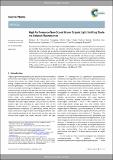Files in this item
High performance non-doped green organic light emitting diode via delayed fluorescence
Item metadata
| dc.contributor.author | Sk, Bahadur | |
| dc.contributor.author | Thangaraji, Vasudevan | |
| dc.contributor.author | Yadav, Nisha | |
| dc.contributor.author | Nanda, Gyana Prakash | |
| dc.contributor.author | Das, Sannibha | |
| dc.contributor.author | Gandeepan, Parthasarathy | |
| dc.contributor.author | Zysman-Colman, Eli | |
| dc.contributor.author | Rajamalli, Pachaiyappan | |
| dc.date.accessioned | 2022-10-13T23:40:48Z | |
| dc.date.available | 2022-10-13T23:40:48Z | |
| dc.date.issued | 2021-11-21 | |
| dc.identifier | 276486649 | |
| dc.identifier | 8b8faf61-ab4e-4487-801f-51737e0d22cd | |
| dc.identifier | 85119828268 | |
| dc.identifier | 000711953300001 | |
| dc.identifier.citation | Sk , B , Thangaraji , V , Yadav , N , Nanda , G P , Das , S , Gandeepan , P , Zysman-Colman , E & Rajamalli , P 2021 , ' High performance non-doped green organic light emitting diode via delayed fluorescence ' , Journal of Materials Chemistry C , vol. 2021 , no. 43 , pp. 15583-15590 . https://doi.org/10.1039/D1TC03849D | en |
| dc.identifier.issn | 2050-7526 | |
| dc.identifier.other | ORCID: /0000-0001-7183-6022/work/102725738 | |
| dc.identifier.uri | https://hdl.handle.net/10023/26192 | |
| dc.description | Funding: P. G. thanks the Science & Engineering Research Board (SERB), India, for the Start-up Research Grant (SRG) (Grant No: SRG/2020/000161). E.Z-C. thanks the Engineering and Physical Sciences Research Council (EPSRC) EP/P010482/1 and Royal Society Leverhulme Trust Senior Research fellow (SRF\R1\20108 for support. P. R. thanks the Indian Institute of Science (IISc) for generous financial support and the Science & Engineering Research Board (SERB), India, for the SERB-Power Grant (SPG) (Grant No: SPG/2020/000107). B.S. thank IISc for the C. V. Raman Fellowship under the Institute of Eminence (IoE). | en |
| dc.description.abstract | Non-doped, delayed fluorescence organic light-emitting diodes (OLEDs) provide a route to high performance devices and simplified device fabrication. Here, two ambipolar anthracene derivatives containing a hole-transporting di-p-tolylamine and a carbazole and an electron-transporting phosphine oxide moiety are rationally designed and synthesized. The thermal and optoelectronic properties were investigated and the neat films of these compounds show high photoluminescence quantum yields of 84–87%. Non-doped OLEDs with these luminogens exhibit green emission at ∼545 nm and an EQEmax of over 7.2% due to the delayed fluorescence resulting from triplet–triplet annihilation (TTA). The devices show a high luminance of over 104 400 cd m−2. Power efficiency and current efficiency maxima are up to 23.0 lm W−1 and 28.3 cd A−1, respectively. Moreover, the devices show very low efficiency roll-off and retain 90% of the maximum efficiency even at 20 000 cd m−2. When combined with a thermally activated delayed fluorescent (TADF) assistant dopant, the green-emitting OLEDs show a high EQEmax of 17.8%. | |
| dc.format.extent | 8 | |
| dc.format.extent | 1846483 | |
| dc.language.iso | eng | |
| dc.relation.ispartof | Journal of Materials Chemistry C | en |
| dc.subject | QD Chemistry | en |
| dc.subject | DAS | en |
| dc.subject | MCC | en |
| dc.subject.lcc | QD | en |
| dc.title | High performance non-doped green organic light emitting diode via delayed fluorescence | en |
| dc.type | Journal article | en |
| dc.contributor.sponsor | EPSRC | en |
| dc.contributor.sponsor | The Leverhulme Trust | en |
| dc.contributor.institution | University of St Andrews. Organic Semiconductor Centre | en |
| dc.contributor.institution | University of St Andrews. EaSTCHEM | en |
| dc.contributor.institution | University of St Andrews. School of Chemistry | en |
| dc.identifier.doi | https://doi.org/10.1039/D1TC03849D | |
| dc.description.status | Peer reviewed | en |
| dc.date.embargoedUntil | 2022-10-14 | |
| dc.identifier.grantnumber | EP/P010482/1 | en |
| dc.identifier.grantnumber | RPG-2016-047 | en |
This item appears in the following Collection(s)
Items in the St Andrews Research Repository are protected by copyright, with all rights reserved, unless otherwise indicated.

